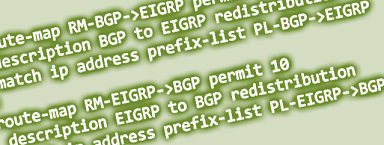
It’s said that you’re never to old too learn. I agree, and in fact it’s one of the things that has kept me in the networking industry for so long; there’s always something new going on to keep me interested.
And learn, I did, from a recent set of twitter interactions, some of which I’ll reproduce here in order to share the love with you all as well!
Route-Map Naming
I was browsing some old configurations (not mine, by the way) and came across a route-map which triggered the following tweet:

I am not, as you can tell, a fan of using numbers when a word will do just as well. Older readers will also recall that I like naming things sensibly. So take your “ROUTES4REDIST” prefix-list and bite my shiny metal rack post. One response to this tweet stood out to me though. Bob McCouch (@BobMcCouch) offered the following:

Old Dog, New Tricks
First of all, let’s take a moment to applaud Bob for being shameless enough to use a picture of him in his Cisco Live 2013 Orland CAE hat as his Twitter avatar. Bravo, sir! Spongebob McCouch, indeed. 🙂 Anyway, I like this idea. I had no idea that you could use “>” in a route-map name, and indeed I don’t think I have ever seen it in a configuration.
A couple of people said they had come across this while studying for an exam (maybe the CCNP Troubleshooting exam?). As Bob says, BGP->EIGRP seems pretty clear what it does. Of course, so is “BGP-TO-EIGRP”, but it doesn’t look quite as cute, does it? I guess it’s all preference, but it’s nice to have another reasonable option out there.
Why is this new to me though? I don’t know. Maybe it’s relatively new (I suspect not) or more likely it just isn’t commonly known. It appears to apply to both route-map and prefix-list names from what I can see too.
So there you have it. I learned something new, and I’m sharing it so that if you don’t already know it, you can learn it too!



I use the “->” characters like Bob does. Pretty sure I first encountered it in a training module somewhere. Love it.
Other than redistribution, I don’t use hyphens much when naming objects anymore. I used to name all of my ACLs, prefix lists, certificate maps and whathaveyou like this:
ACL-DESCRIPTIVE-NAME-POSSIBLY-MORE-DETAIL
PL-THIS-IS-A-PREFIX-LIST
etc…
I found that un-shifting to get the hyphen slowed me down more than I like. Everything is underscores now:
EXAMPLE_MUCH_EASEIR_TO_TYPE
I agree. I tend to end up using whatever’s in place where I go – because if – is bad compared to _, there’s nothing worse than inconsistency in the router where some use – and some use _; it’s a guaranteed mistake waiting to happen.
j.
As a side note, the reason I used RM-BGP->EIGRP was because it felt messy and inconsistent to use RM_BGP->EIGRP, mixing underscores and dashes…
I have 3 principles when I configure and I’m not tied to former conventions:
1) Hungarian notation
After reading a good old article about “hungarian notation” (http://en.wikipedia.org/wiki/Hungarian_notation) in c computer programming, I started using extensively in my object naming.
instead of RM-THIS-IS-A-ROUTE-MAP,
I use rmTHIS-IS-A-ROUTE-MAP.
The lower prefix is IMHO simpler to catch as a “type” (prefix, acl, route-map), expecially when you have several object types (VPN on ASAs, anyone?)
2) dash vs underscores
As a separator, I use both dash and undescore, using dash with same object attribute, and underscore to differentiate objects. e.g.
aclRouterA-g0-0_TO_RouterB-g0-1
3) DO NOT USE SPACE.
Easier to remember, and cut/paste between interface descrition and vlan name is a snap 🙂
And of course, just like everyone who does not have long term memory, I prefer as self descriptive names as I can.
My two cents.
i.
Ivan,
#1 and #3 are great. Thanks for the pointer to Hungarian notation, and also for sharing your no_spaces logic. Brilliant.
#2 I understand, but expect I would hate life if I tried to use it.
I’m glad I circled back to see the commentary here.
Definitely – I’m glad I have such awesome readers to share their ideas and experience with us! I love getting new thoughts on old problems like this.